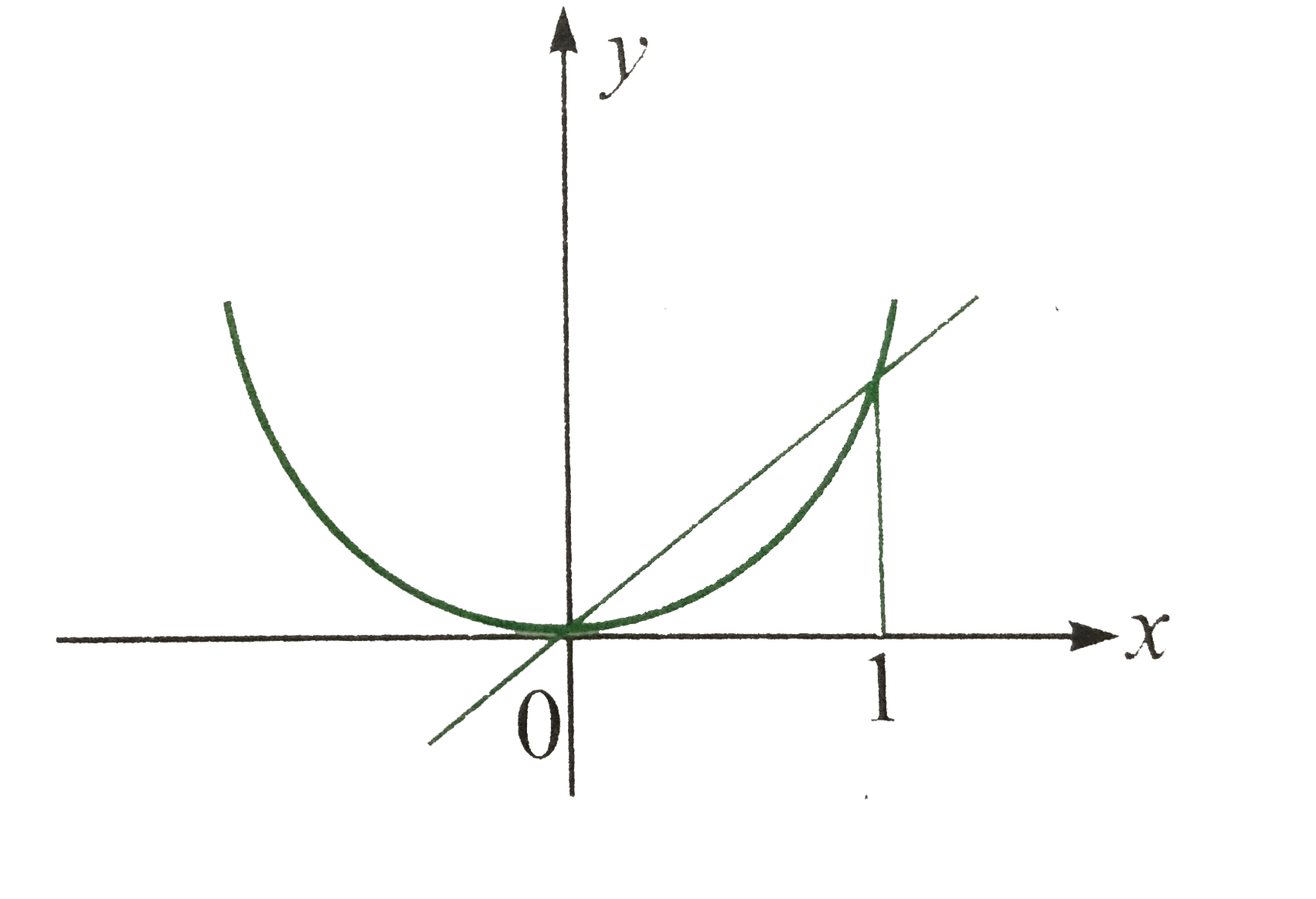If An is the area bounded by y=x and y=xn,n∈N ,then A2A3...An= (a) 1n(n+1) (b) 12nn(n+1) (c) 12n−1n(n+1) (d) 12n−2n(n+1)Solution in Bengali
1n(n+1)
12nn(n+1)
12n−1n(n+1)
12n−2n(n+1)
The correct Answer is:D
y=x intersect y=xn at (0,0)and(1,0) for all n∈N

Area An=1∫0(x−xn)dx
=[x22−xn+1n+1]10
=12−1n+1
=n−12(n+1)
Thus, A2⋅A3⋅A4....An=12n−1(13⋅24⋅35...n−1n+1)
=12n−2.n(n+1)
Topper's Solved these Questions
- BOOK - CENGAGE PUBLICATIONCHAPTER - AREAEXERCISE - Multiple Correct Answers Type13videos
AREA
- BOOK - CENGAGE PUBLICATIONCHAPTER - AREAEXERCISE - Linkded Comprehension Type21videos
AREA
- BOOK - CENGAGE PUBLICATIONCHAPTER - AREAEXERCISE - Concept Application Exercise 9.37videos
AREA
- BOOK - CENGAGE PUBLICATIONCHAPTER - APPLICATIONS OF DERIVATIVESEXERCISE - Subjective Type2videos
APPLICATIONS OF DERIVATIVES
- BOOK - CENGAGE PUBLICATIONCHAPTER - BINOMIAL THEOREMEXERCISE - Comprehension11videos
BINOMIAL THEOREM
Similar Questions
Let A(k) be the area bounded by the curves y=x2−3 and y=kx+2 The range of A(k) is (10√53,∞) The range of A(k) is (20√53,∞) If function k→A(k) is defined for k∈[−2,∞ ), then A(k) is many-one function. The value of k for which area is minimum is 1.
03:16View SolutionLet Ar be the area of the region bounded between the curves y2=(e−kr)x(where k>0,r∈N) and the line y=mx(where m≠0), k and m are some constants
A1,A2,A3,… are in G.P. with common ratio01:23View SolutionFind the continuous function f where (x4−4x2)≤f(x)≤(2x2−x3) such that the area bounded by y=f(x),y=x4−4x2. then y-axis, and the line x=t, where (0≤t≤2) is k times the area bounded by y=f(x),y=2x2−x3,y-axis , and line x=t(where0≤t≤2).
02:59View SolutionProve that for λ>1, the equation xlogx+x=λ has least one solution in [1,λ].
03:40View SolutionConsider a G.P. with first term (1+x)n, |x|<1, common ratio 1+x2 and number of terms (n+1). Let 'S' be sum of all the terms of the G.P., then
The coefficient of xn is 'S' is02:22View Solutiondndxn(logx)= (a)(n−1)!xn (b) n!xn (c)(n−2)!xn (d) (−1)n−1(n−1)!xn
View SolutionIf y=axn+1+bx−n , then x2d2ydx2= (a)n(n−1)y (b) n(n+1)y (c) ny (d) n2y
04:31View Solution(x2n−1+y2n−1)(x2n−1−y2n−1)=
03:10View Solution{an}and{bn} are two sequences given by an=(x)1/2n+(y)1/2nandbn=(x)1/2n−(y)1/2n for all n ∈ N. The value of a1a2a3……..an is equal to
02:59View SolutionThe Fibonacci sequence is defined by 1=a1=a2 and an=an−1+an−2,n>2. Find an+1an,for n = 1, 2, 3, 4, 5.
05:48View SolutionIf an=1+2+3+......+nn! then a1+a2+a3+....∞=
05:28View SolutionIf αandβ are the rootsof he equations x2−ax+b=0andAn=αn+βn , then which of the following is true? a.An+1=aAn+bAn−1 b. An+1=bAn−1+aAn c. An+1=aAn−bAn−1 d. An+1=bAn−1−aAn
01:35View SolutionIf An is the area bounded by y=x and y=xn,n∈N ,then A2A3...An= (a) 1n(n+1) (b) 12nn(n+1) (c) 12n−1n(n+1) (d) 12n−2n(n+1)
04:06View SolutionIf y=axn+1+bx−n , then x2d2ydx2= n(n−1)y (b) n(n+1)y (c) ny (d) n2y
07:26View SolutionThe Fibonacci sequence is defined by 1=a1=a2 and an=an−1+an−2, n>2. Find an+1an , for n = 1, 2, 3, 4, 5
04:15View Solutionਫ਼ਿੱਬੋਨਾਕੀ ਅਨੁਕ੍ਰਮ ਹੇਠ ਲਿਖੇ ਅਨੁਸਾਰ ਪਰਿਭਾਸ਼ਿਤ ਹੈ 1=a1=a2 ਅਤੇ an=an−1+an−2, n>2 ਤਾਂ an+1an, n = 1, 2, 3, 4, 5 ਲਈ ਪਤਾ ਕਰੋ।
05:25View Solution

